Abstract
1 To compare the haemodynamic effects of secondary characteristics of beta-adrenoceptor blockers with an angiotensin converting enzyme inhibitor forty patients with previously untreated mild to moderate hypertension were prescribed either atenolol 50-100 mg day-1, labetalol 200-800 mg day-1, pindolol 10-30 mg day-1 or captopril 25-100 mg day-1 and observed for 6 months. 2 Over this period: (a) All four drugs produced similar reductions in blood pressure at rest (P less than or equal to 0.01) and after exercise (P less than or equal to 0.01). (b) All four drugs significantly decreased resting forearm (P less than or equal to 0.01) and calf blood flow (P less than or equal to 0.01). They all also caused a significant reduction in the increased calf blood flow following exercise (P less than or equal to 0.01). (c) No drug produced a change in resting forearm vascular resistance, while resting calf vascular resistance was decreased by captopril and pindolol, unaltered by labetalol and increased by atenolol. Post-exercise calf vascular resistance was increased by atenolol, labetalol and pindolol but unaltered by captopril. (d) Although all four drugs produced a fall in resting heart rate this was significantly greater for atenolol and labetalol (P less than or equal to 0.01). All four treatments however significantly reduced the increase in heart rate following exercise (P less than or equal to 0.01). (e) No drug produced any significant change in resting and post-exercise stroke volume/ejection fraction. 3 It is concluded that despite differing modes of action all four drugs reduce limb blood flow. This primarily appears to be a consequence of reduced perfusion pressure associated with limited autoregulation of skeletal muscle circulation. The reduction in arterial vascular resistance produced by captopril and pindolol is inconsistent and does not appear of major benefit in preserving limb blood flow. The reduction in perfusion with the agents studied may in part be related to a fall in cardiac output associated with decreased heart rate. This suggests that captopril may exert antisympathetic activity when used as an antihypertensive agent.
Full text
PDF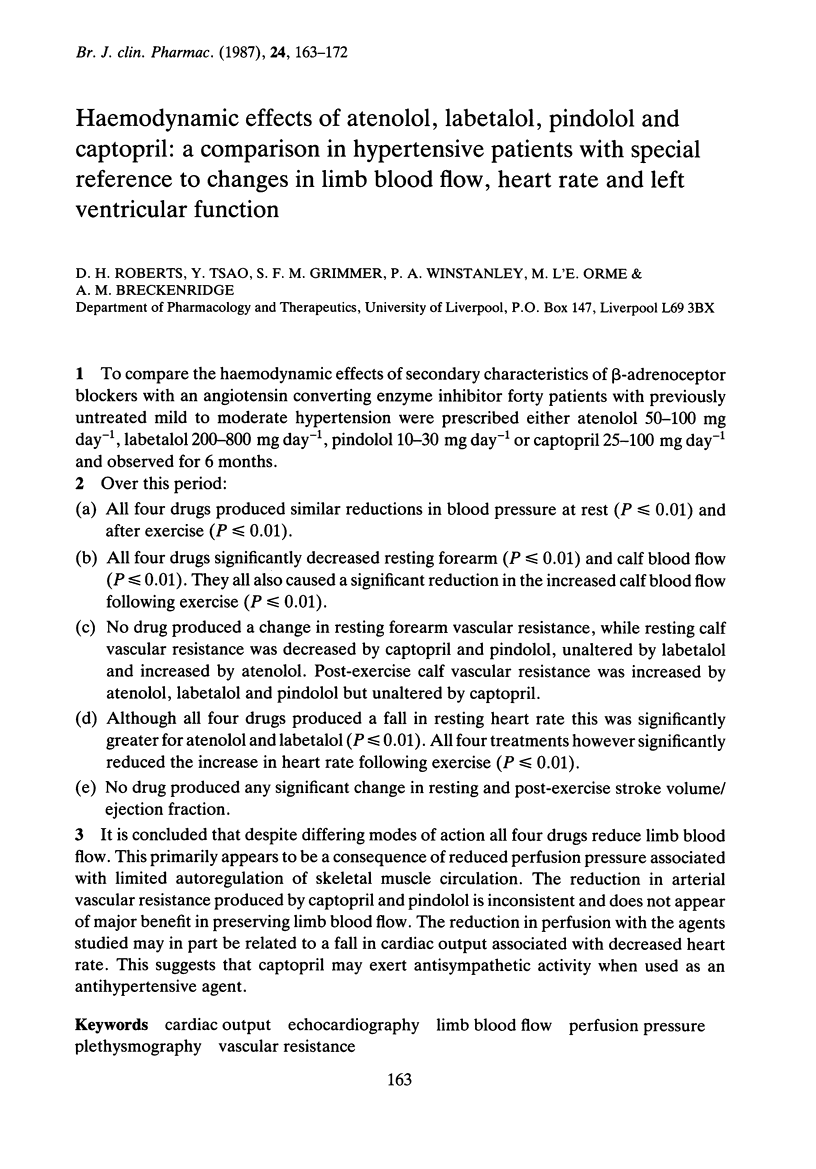
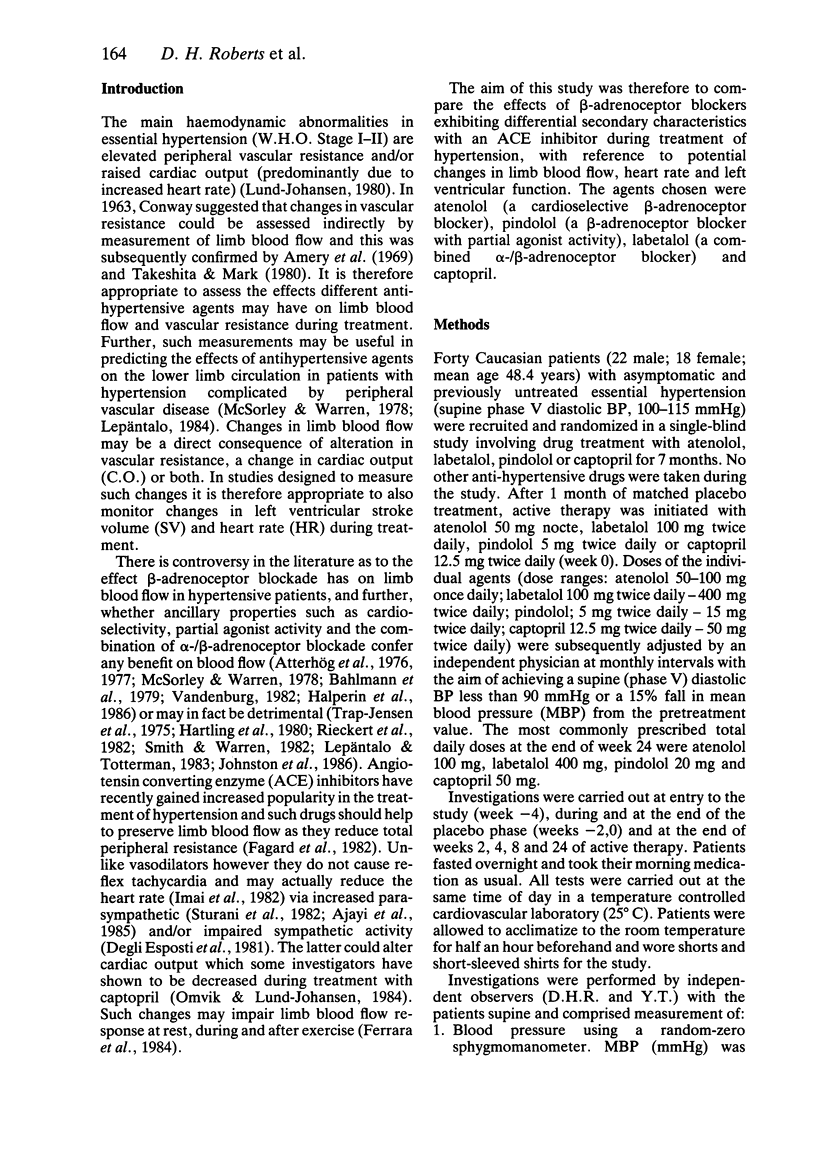
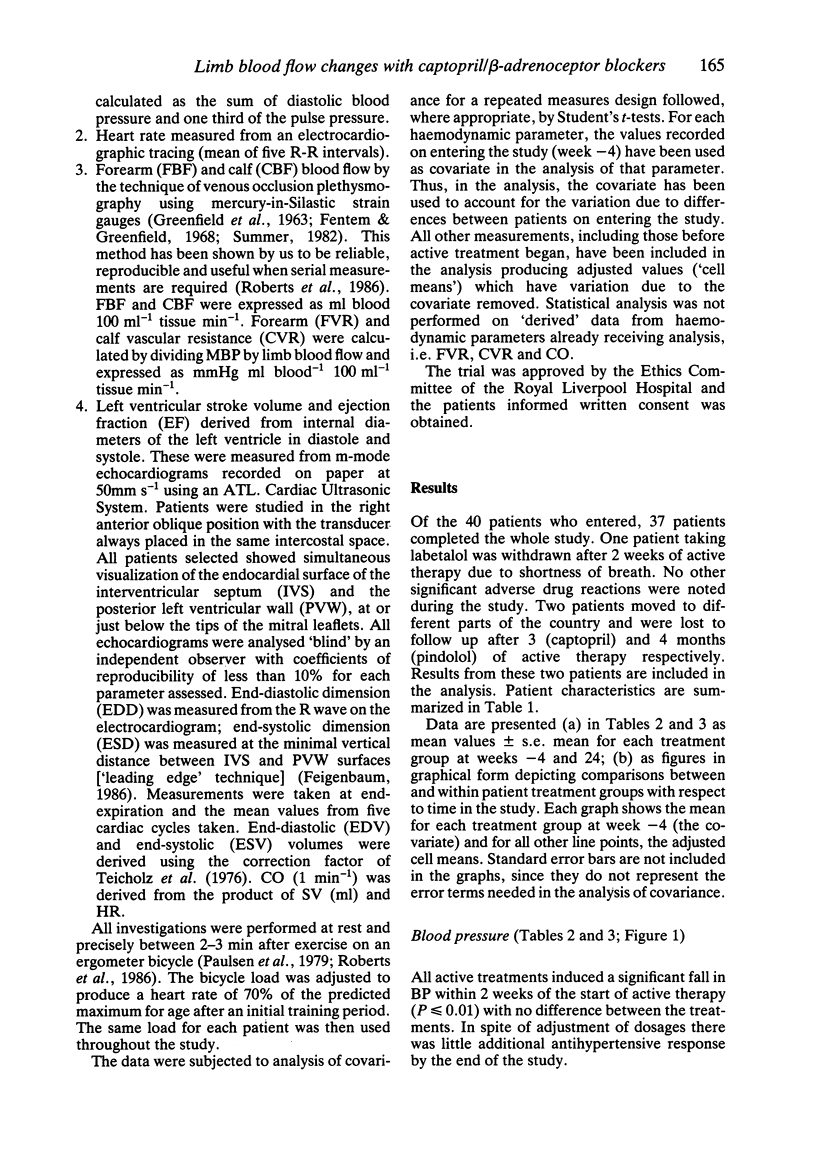
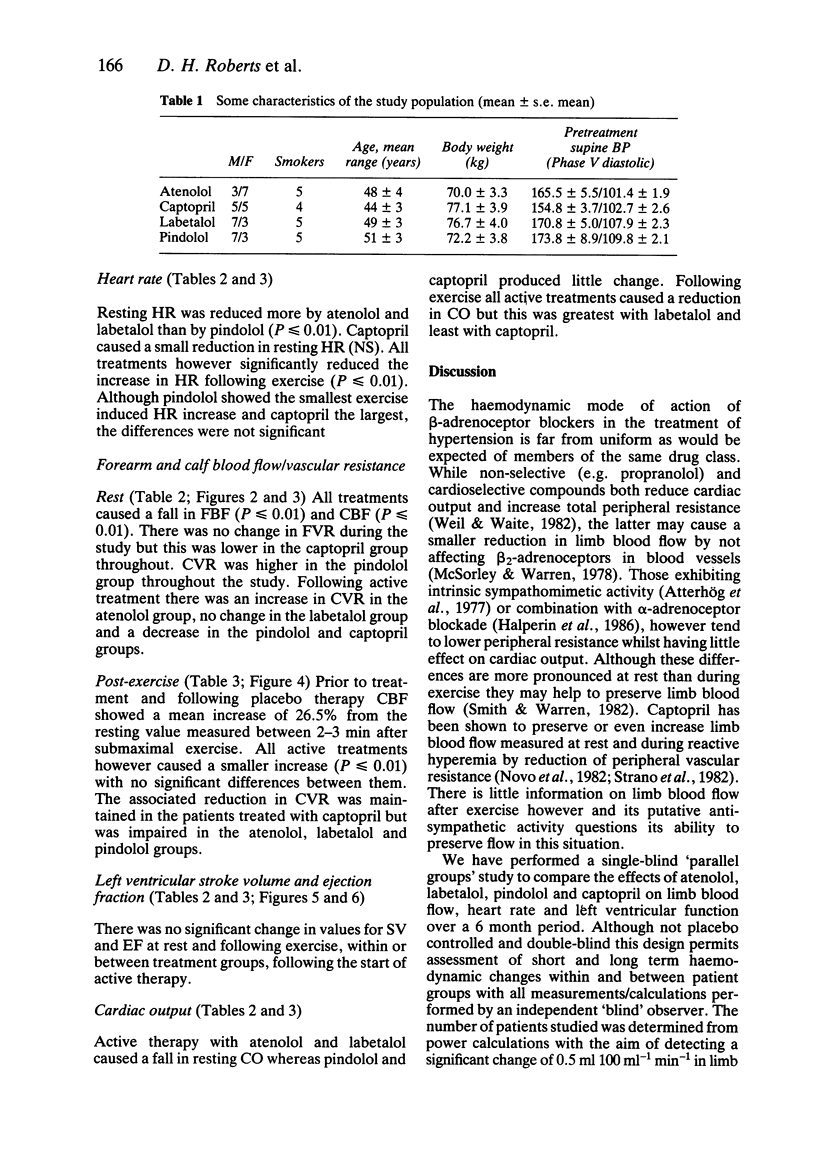
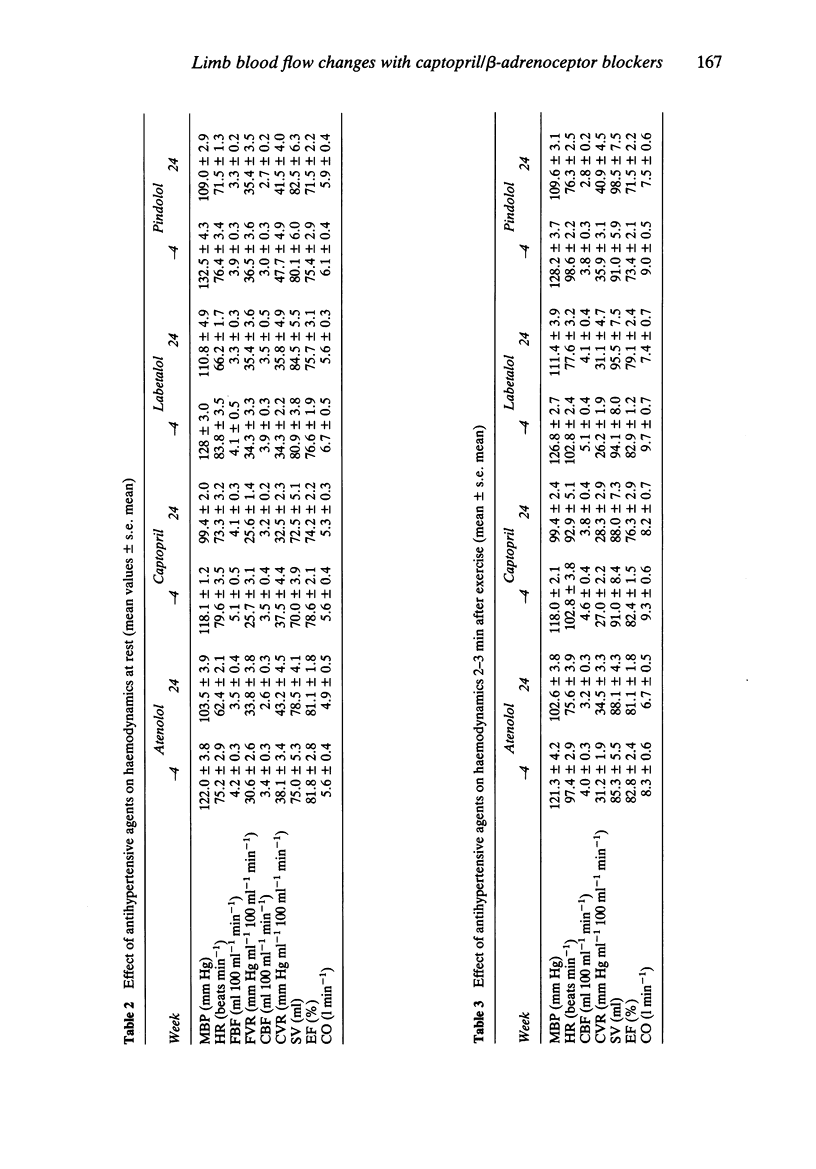
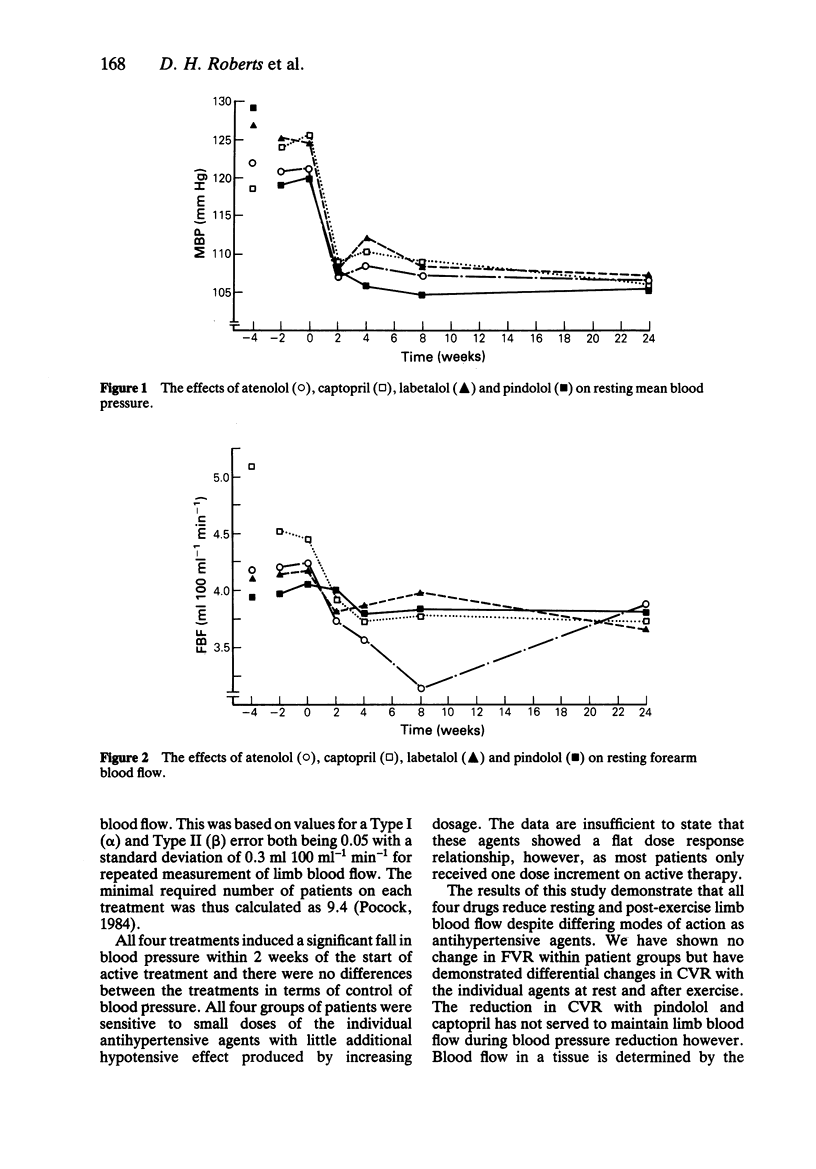
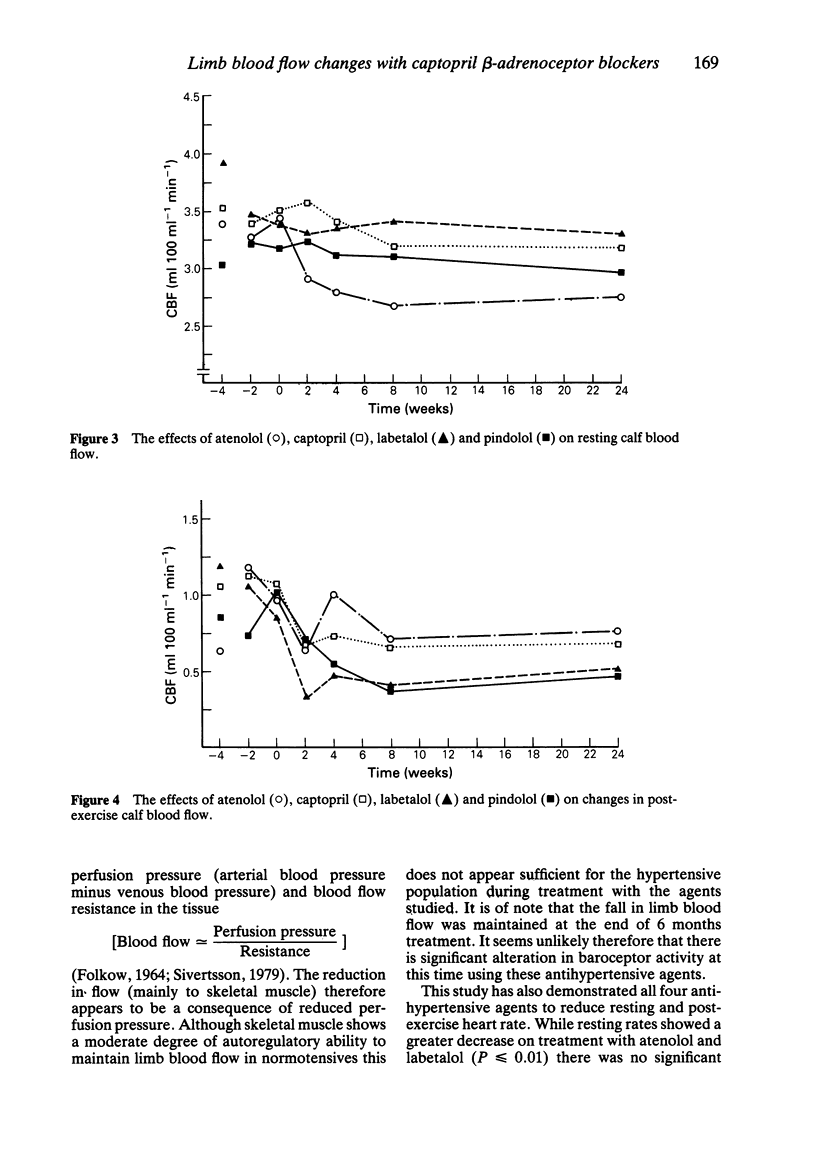
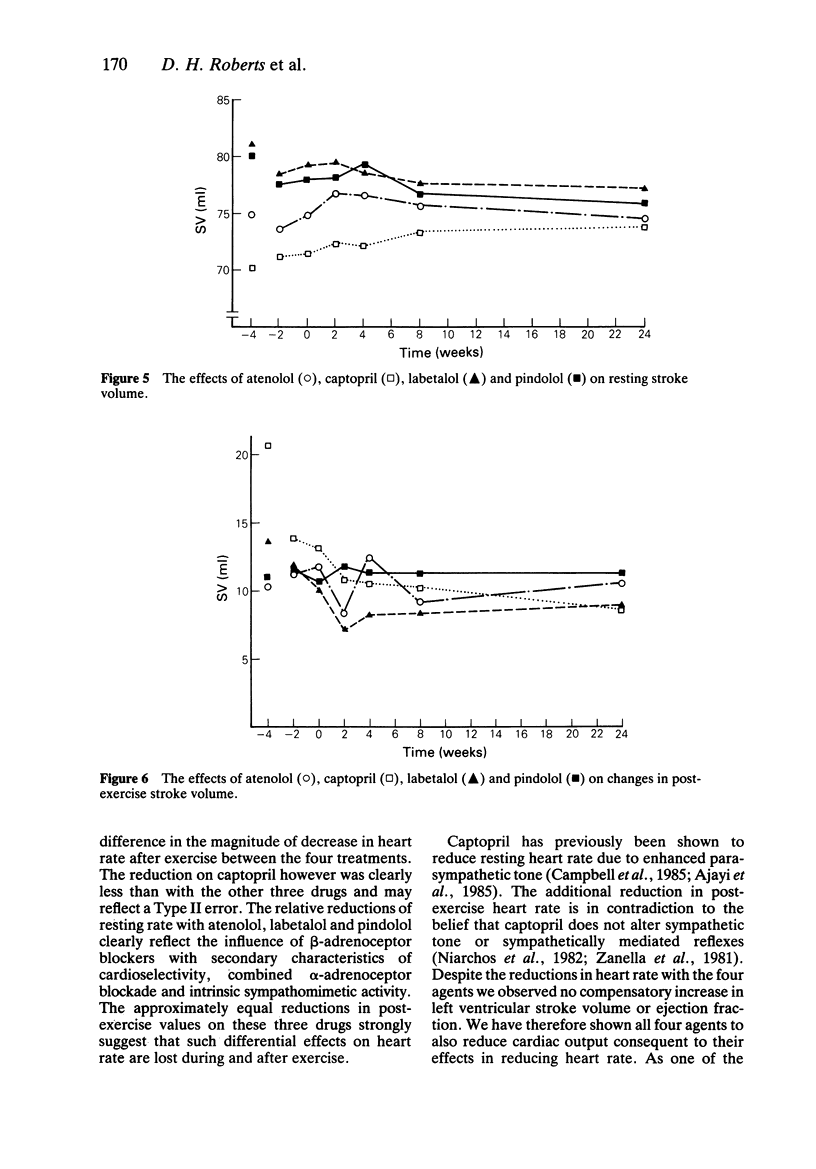
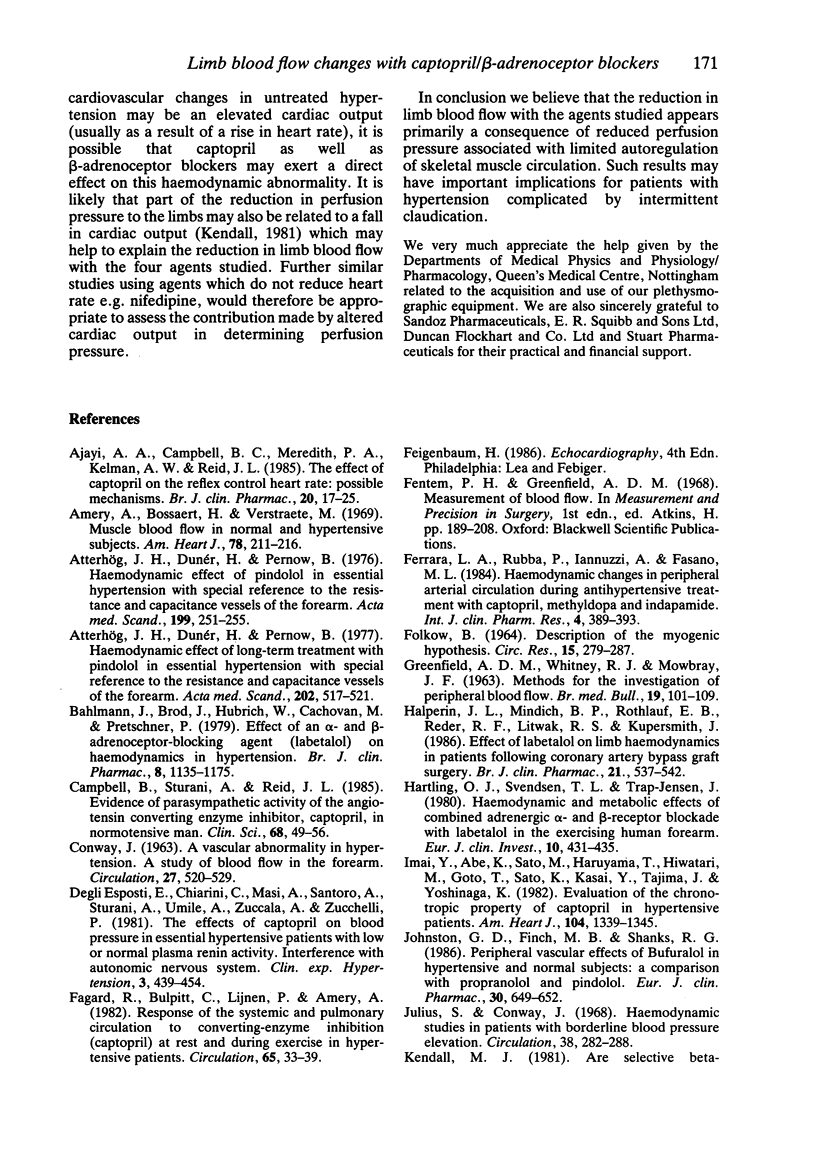
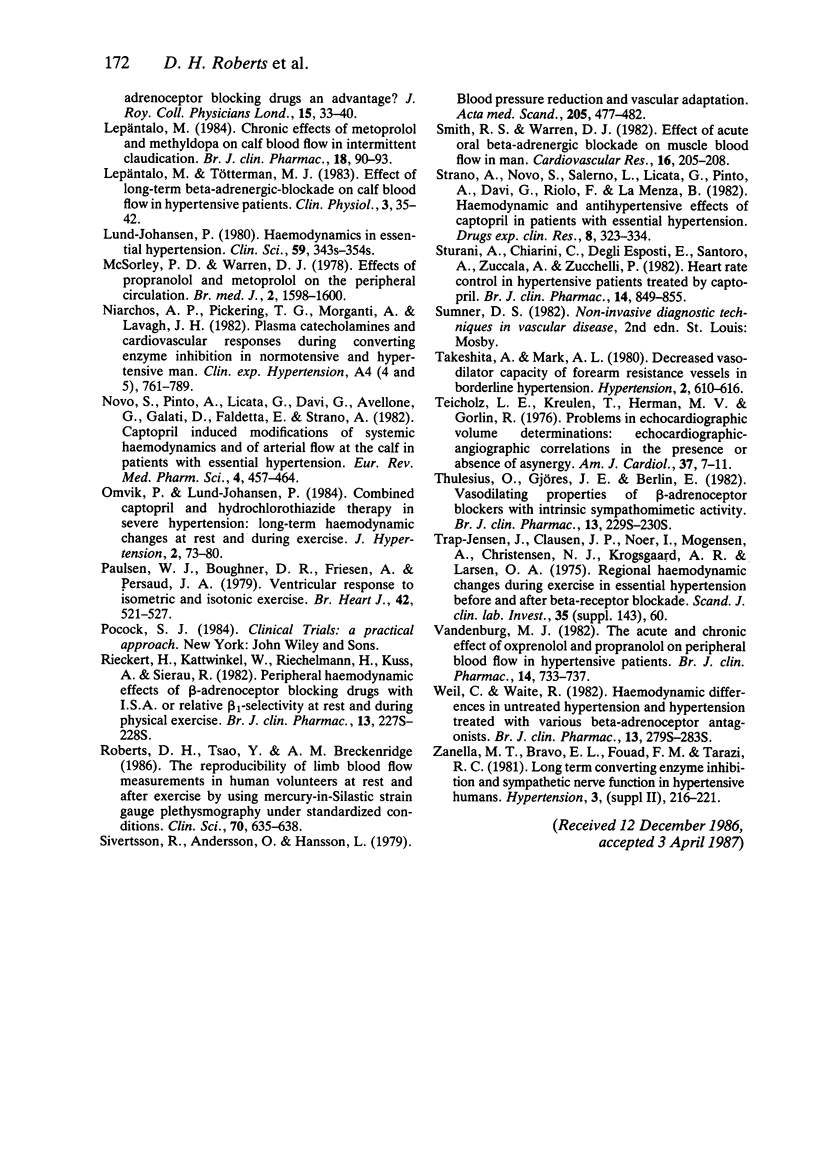
Selected References
These references are in PubMed. This may not be the complete list of references from this article.
- Ajayi A. A., Campbell B. C., Meredith P. A., Kelman A. W., Reid J. L. The effect of captopril on the reflex control heart rate: possible mechanisms. Br J Clin Pharmacol. 1985 Jul;20(1):17–25. doi: 10.1111/j.1365-2125.1985.tb02793.x. [DOI] [PMC free article] [PubMed] [Google Scholar]
- Amery A., Bossaert H., Verstraete M. Muscle blood flow in normal and hypertensive subjects. Influence of age, exercise, and body position. Am Heart J. 1969 Aug;78(2):211–216. doi: 10.1016/0002-8703(69)90010-6. [DOI] [PubMed] [Google Scholar]
- Atterhög J. H., Dunér H., Pernow B. Hemodynamic effect of long--term treatment with pindolol in essential hypertension with special reference to the resistance and capacitance vessels of the forearm. Acta Med Scand. 1977;202(6):517–521. doi: 10.1111/j.0954-6820.1977.tb16874.x. [DOI] [PubMed] [Google Scholar]
- Atterhög J. H., Dunér H., Pernow B. Hemodynamic effect of pindolol in essential hypertension with special reference to the resistance and capacitance vessels of the forearm. Acta Med Scand. 1976;199(4):251–255. doi: 10.1111/j.0954-6820.1976.tb06728.x. [DOI] [PubMed] [Google Scholar]
- CONWAY J. A vascular abnormality in hypertension. A study of blood flow in the forearm. Circulation. 1963 Apr;27(4 Pt 1):520–529. doi: 10.1161/01.cir.27.4.520. [DOI] [PubMed] [Google Scholar]
- Campbell B. C., Sturani A., Reid J. L. Evidence of parasympathetic activity of the angiotensin converting enzyme inhibitor, captopril, in normotensive man. Clin Sci (Lond) 1985 Jan;68(1):49–56. doi: 10.1042/cs0680049. [DOI] [PubMed] [Google Scholar]
- Degli Esposti E., Chiarini C., Masi A., Santoro A., Sturani A., Umile A., Zuccalà A., Zucchelli P. The effects of captopril on blood pressure in essential hypertensive patients with low or normal plasma renin activity. Interference with autonomic nervous system. Clin Exp Hypertens. 1981;3(3):439–454. doi: 10.3109/10641968109033675. [DOI] [PubMed] [Google Scholar]
- FOLKOW B. DESCRIPTION OF THE MYOGENIC HYPOTHESIS. Circ Res. 1964 Aug;15:SUPPL–SUPPL:287. [PubMed] [Google Scholar]
- Fagard R., Bulpitt C., Lijnen P., Amery A. Response of the systemic and pulmonary circulation to converting-enzyme inhibition (captopril) at rest and during exercise in hypertensive patients. Circulation. 1982 Jan;65(1):33–39. doi: 10.1161/01.cir.65.1.33. [DOI] [PubMed] [Google Scholar]
- Ferrara L. A., Rubba P., Iannuzzi A., Fasano M. L. Haemodynamic changes in peripheral arterial circulation during antihypertensive treatment with captopril, methyldopa and indapamide. Int J Clin Pharmacol Res. 1984;4(5):389–393. [PubMed] [Google Scholar]
- GREENFIELD A. D., WHITNEY R. J., MOWBRAY J. F. Methods for the investigation of peripheral blood flow. Br Med Bull. 1963 May;19:101–109. doi: 10.1093/oxfordjournals.bmb.a070026. [DOI] [PubMed] [Google Scholar]
- Halperin J. L., Mindich B. P., Rothlauf E. B., Reder R. F., Litwak R. S., Kupersmith J. Effect of labetalol on limb haemodynamics in patients following coronary artery bypass graft surgery. Br J Clin Pharmacol. 1986 May;21(5):537–542. doi: 10.1111/j.1365-2125.1986.tb02839.x. [DOI] [PMC free article] [PubMed] [Google Scholar]
- Hartling O. J., Svendsen T. L., Trap-Jensen J. Haemodynamic and metabolic effects of combined adrenergic alpha- and beta-receptor blockade with labetalol in the exercising human forearm. Eur J Clin Invest. 1980 Dec;10(6):431–435. doi: 10.1111/j.1365-2362.1980.tb02081.x. [DOI] [PubMed] [Google Scholar]
- Imai Y., Abe K., Sato M., Haruyama T., Hiwatari M., Goto T., Sato K., Kasai Y., Tajima J., Yoshinaga K. Evaluation of the chronotropic property of captopril in hypertensive patients. Am Heart J. 1982 Dec;104(6):1339–1345. doi: 10.1016/0002-8703(82)90165-x. [DOI] [PubMed] [Google Scholar]
- Johnston G. D., Finch M. B., Shanks R. G. Peripheral vascular effects of bufuralol in hypertensive and normal subjects: a comparison with propranolol and pindolol. Eur J Clin Pharmacol. 1986;30(6):649–652. doi: 10.1007/BF00608210. [DOI] [PubMed] [Google Scholar]
- Julius S., Conway J. Hemodynamic studies in patients with borderline blood pressure elevation. Circulation. 1968 Aug;38(2):282–288. doi: 10.1161/01.cir.38.2.282. [DOI] [PubMed] [Google Scholar]
- Kendall M. J. Are selective beta-adrenoceptor blocking drugs an advantage? J R Coll Physicians Lond. 1981 Jan;15(1):33–40. [PMC free article] [PubMed] [Google Scholar]
- Lepäntalo M. Chronic effects of metoprolol and methyldopa on calf blood flow in intermittent claudication. Br J Clin Pharmacol. 1984 Jul;18(1):90–93. doi: 10.1111/j.1365-2125.1984.tb05027.x. [DOI] [PMC free article] [PubMed] [Google Scholar]
- Lepäntalo M., Tötterman K. J. Effect of long-term beta-adrenergic-blockade on calf blood flow in hypertensive patients. Clin Physiol. 1983 Feb;3(1):35–42. doi: 10.1111/j.1475-097x.1983.tb00696.x. [DOI] [PubMed] [Google Scholar]
- Lund-Johansen P. Haemodynamics in essential hypertension. Clin Sci (Lond) 1980 Dec;59 (Suppl 6):343s–354s. doi: 10.1042/cs059343s. [DOI] [PubMed] [Google Scholar]
- McSorley P. D., Warren D. J. Effects of propranolol and metoprolol on the peripheral circulation. Br Med J. 1978 Dec 9;2(6152):1598–1600. doi: 10.1136/bmj.2.6152.1598. [DOI] [PMC free article] [PubMed] [Google Scholar]
- Niarchos A. P., Pickering T. G., Morganti A., Laragh J. H. Plasma catecholamines and cardiovascular responses during converting enzyme inhibition in normotensive and hypertensive man. Clin Exp Hypertens A. 1982;4(4-5):761–789. doi: 10.3109/10641968209061612. [DOI] [PubMed] [Google Scholar]
- Omvik P., Lund-Johansen P. Combined captopril and hydrochlorothiazide therapy in severe hypertension: long-term haemodynamic changes at rest and during exercise. J Hypertens. 1984 Feb;2(1):73–80. doi: 10.1097/00004872-198402000-00013. [DOI] [PubMed] [Google Scholar]
- Paulsen W. J., Boughner D. R., Friesen A., Persaud J. A. Ventricular response to isometric and isotonic exercise. Echocardiographic assessment. Br Heart J. 1979 Nov;42(5):521–527. doi: 10.1136/hrt.42.5.521. [DOI] [PMC free article] [PubMed] [Google Scholar]
- Rieckert H., Kattwinkel W., Riechelmann H., Kuss A., Sierau R. Peripheral haemodynamic effects of beta-adrenoceptor blocking drugs with ISA or relative beta 1-selectivity at rest and during physical exercise. Br J Clin Pharmacol. 1982;13(Suppl 2):227S–228S. doi: 10.1111/j.1365-2125.1982.tb01916.x. [DOI] [PMC free article] [PubMed] [Google Scholar]
- Roberts D. H., Tsao Y., Breckenridge A. M. The reproducibility of limb blood flow measurements in human volunteers at rest and after exercise by using mercury-in-Silastic strain gauge plethysmography under standardized conditions. Clin Sci (Lond) 1986 Jun;70(6):635–638. doi: 10.1042/cs0700635. [DOI] [PubMed] [Google Scholar]
- Sivertsson R., Andersson O., Hansson L. Blood pressure reduction and vascular adaptation. A study on long-term effects of treatment with mefruside or atenolol. Acta Med Scand. 1979;205(6):477–482. [PubMed] [Google Scholar]
- Smith R. S., Warren D. J. Effect of acute oral beta adrenergic blockade on muscle blood flow in man. Cardiovasc Res. 1982 Apr;16(4):205–208. doi: 10.1093/cvr/16.4.205. [DOI] [PubMed] [Google Scholar]
- Sturani A., Chiarini C., Degliesposti E., Santoro A., Zuccalà A., Zucchelli P. Heart rate control in hypertensive patients treated by captopril. Br J Clin Pharmacol. 1982 Dec;14(6):849–855. doi: 10.1111/j.1365-2125.1982.tb02048.x. [DOI] [PMC free article] [PubMed] [Google Scholar]
- Takeshita A., Mark A. L. Decreased vasodilator capacity of forearm resistance vessels in borderline hypertension. Hypertension. 1980 Sep-Oct;2(5):610–616. doi: 10.1161/01.hyp.2.5.610. [DOI] [PubMed] [Google Scholar]
- Teichholz L. E., Kreulen T., Herman M. V., Gorlin R. Problems in echocardiographic volume determinations: echocardiographic-angiographic correlations in the presence of absence of asynergy. Am J Cardiol. 1976 Jan;37(1):7–11. doi: 10.1016/0002-9149(76)90491-4. [DOI] [PubMed] [Google Scholar]
- Thulesius O., Gjöres J. E., Berlin E. Vasodilating properties of beta-adrenoceptor blockers with intrinsic sympathomimetic activity. Br J Clin Pharmacol. 1982;13(Suppl 2):229S–230S. doi: 10.1111/j.1365-2125.1982.tb01917.x. [DOI] [PMC free article] [PubMed] [Google Scholar]
- Vandenburg M. J. The acute and chronic effect of oxprenolol and propranolol on peripheral blood flow in hypertensive patients. Br J Clin Pharmacol. 1982 Nov;14(5):733–737. doi: 10.1111/j.1365-2125.1982.tb04965.x. [DOI] [PMC free article] [PubMed] [Google Scholar]
- Weil C., Waite R. Haemodynamic differences in untreated hypertension and hypertension treated with various beta-adrenoceptor antagonists. Br J Clin Pharmacol. 1982;13(Suppl 2):279S–283S. doi: 10.1111/j.1365-2125.1982.tb01925.x. [DOI] [PMC free article] [PubMed] [Google Scholar]
- Zanella M. T., Bravo E. L., Fouad F. M., Tarazi R. C. Long-term converting enzyme inhibition and sympathetic nerve function in hypertensive humans. Hypertension. 1981 Nov-Dec;3(6 Pt 2):II–216-21. doi: 10.1161/01.hyp.3.6_pt_2.ii-216. [DOI] [PubMed] [Google Scholar]


